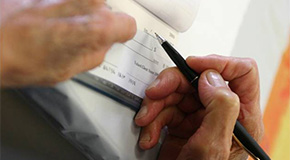Even as paper checks are rapidly falling out of fashion with consumers, they are more popular than ever as a target for scammers who steal them out of mailboxes and deposit them in fraudulent accounts.
In 2022, banks filed 680,000 reports of check fraud, according to the Financial Crimes Enforcement Network, which is in the U.S. Treasury Department. That number was almost double the 350,000 reports of check fraud in 2021. And this past November a separate report found that 31 percent of small business had experienced check fraud during the year, with losses often exceeding $50,000.
It may seem odd that scammers are targeting a form of payment that seems to be following dinosaurs, landline phones, and black-and-white TVs into extinction. Credit cards, debit cards, and payment apps, which became more common during the pandemic, all take up a growing share of consumer transactions, as personal checks and U.S. currency play a diminishing role.
At the turn of this century, checks were used in 60 percent of noncash purchases and bill payments, according to the Washington Post. Nowadays, the figure is closer to 5 percent.
But checks have only grown in the interest of scammers. In a technique known as “check washing,” crooks remove checks from mailboxes and apply a chemical wash to erase the ink, enabling them to change names and dollar amounts on the check. (Scammers have been known to fish checks out of mailboxes with the help of glue traps meant to kill rodents, AARP reported.)
Once they capture and alter the check, the fraudsters deposit it in a bank account they control. They also may use copiers to create more phony checks. Stolen checks are being bought and sold online, in bulk, with the help of smartphone apps, the New York Times reported.
The U.S. Postal Service says it recovers more than $1 billion in “counterfeit checks and money orders” annually.
Consumers who write checks can take certain steps to reduce the risk of fraud, according to AARP. These include paying bills online; delivering paper checks to the Post Office, rather than dropping them in a mailbox; writing checks with blue or black nonerasable gel ink; collecting your own mail promptly from the mailbox; paying attention to your checking account; and reporting any problems to your bank right away.

